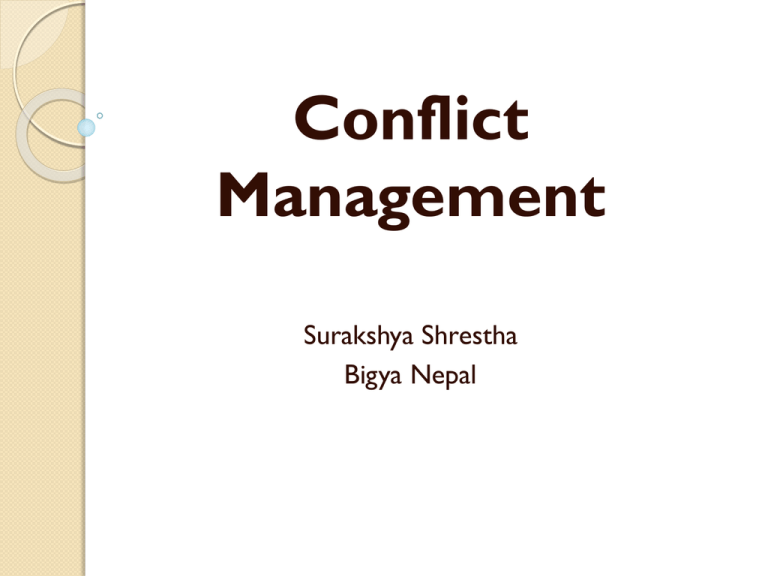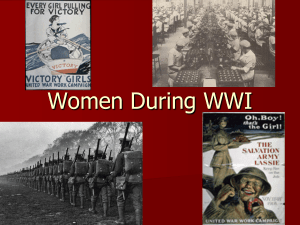
Conflict
Management
Surakshya Shrestha
Bigya Nepal
Definition
Conflict
◦ Internal or external discord that results from differences
in ideas, values, or feelings between two or more
people(Marquis & Huston, 2009).
Conflict management
◦ The long-term management of intractable conflicts and the
people involved in them so that they do not escalate out
of control and become violent (University of Colorado).
Problem solving
◦ Systematic process that focuses on analyzing a difficult
situation (Marquis &Huston, 2009).
Common ground
◦ A basis of mutual interest or agreement.
Issues with conflict in nursing
20% of managerial time is spent dealing with conflict
(Valentine, 2001).
Higher death rates co-related with higher conflicts
between doctors and nurses. Main cause is
communication failure (Northam, 2009).
Medication error, peri-natal deaths and injuries
resulted due to workplace conflict (Northam, 2009).
70% ICU staff members report conflicts, among
which 80% were perceived harmful rather than useful
and half as severe or dangerous. Conflict threatens
quality of care (Azoulay, et.al 2009)
“Studies have shown that the most frequent source of
verbal abuse of the nurses is the other nurses”
(Northam, 2009, pg. 3).
Implications
Social :
◦ Unresolved conflicts results in declining physical, and
emotional health as well as relationships with their
family.
Legal :
◦ JCAHO requires all its health organizations to
develop a process of identifying the causes of conflict
and train all the employees in relationship-building
and collaborative practice in managing conflict.
Cultural :
◦ There is a difference in values, beliefs and preferences
among all the nurses from various cultures which can
add to conflict.
What are nursing professionals
saying about conflict management?
Nursing is a female dominated profession. Most of
the females use passive approach in dealing with
conflict management such as avoidance and
withdrawal. Thus, unresolved conflicts leads to
unhealthy work environment
Literatures suggests that all nurses are not well
trained in conflict management
Dynamic health care system requires nurses to be
efficient in managing conflict
(Northam, 2009,Part 1)
Conflict is viewed as good and bad as well
depending on how it is managed. It can produce
growth or destruction (Marquis & Huston, 2009).
Types of conflict
Intrapersonal
◦ Occurs within the person.
◦ Internal struggle to clarify contradictory values or
wants
Interpersonal
◦ Also known as “horizontal violence” or “bullying”.
◦ It is significant issue confronting the nursing
profession, especially in new graduates
Intergroup
◦ Between two or more people, department or
organization.
◦ Nurses experience this conflict with work and family
issues
Assigned article #1
Conflict in the workplace: Part 1 by
Sally Northam
2009
Causes of conflict among nurses
Cultural differences
Difference in age or position in the
organizational hierarchy
Gender(sex)
Workplace factors
Causes contd…
Cultural differences
◦ Language and communication difficulties: fluency,
accent, unaware of slangs
◦ For example: Asian emphasize respectful
attention to the speaker or a superior
Avoidance of conflict and maintenance of harmony
Age/ hierarchy
◦ Young nurses are not taken seriously by older
nurses
◦ Generational issues: cell phone use, late arrival
create tensions with older nurses.
Causes contd…
Gender
◦ Men are more assertive to resolve conflict
whereas women are more prone to avoid it.
Workplace factors
◦ Workplace has rules which decides who is
right and who is wrong. Conflict arises when
both parties think they are right. Common
ground is difficult to obtain.
◦ Schedule and workload.
Assigned article #2
A gender perspective on conflict
management strategies of nurses by
Patricia E.B.Valentine
2001
Activity
What is your strategy?
1.Avoidance
4. Accommodation
3. compromise
5. Collaboration
2. competition
Common strategies to conflict
management
Avoiding: lose-lose, used when people have
feeling of powerlessness, creates unhealthy work
environment
Accommodating: lose-win, one party neglects
own concerns, self sacrificing
Compromising: no win-no lose, one party gives
up something to satisfy other, middle ground
Collaborating: win-win, one party collaborates
with other to find solution that satisfies both
parties, long term resolution
Competing: win-lose, one party wins other lose.
Assigned article #3
Conflict in the workplace: Part 2 by
Sally Northam
2009
Ways to manage conflict
Through effective communication,
collaborative relationships, and promotion
of nurse’s decision making
Agree on a common goal
◦ Listening with an open mind and assuming
trustworthiness on everyone’s part, even if
beliefs are different
Culture:
◦ Adaptation: acknowledge the cultural gaps and
work around them
Ways to manage conflict
Change the pronouns to “we”
◦ For example, “let’s discuss the ways to reach our
goal.”
Listen actively
◦ Active listening with reflection
Mediator
◦ Neutral party who listens to both side of the
story.
Ways to manage conflict
Position equally
◦ Maintain eye contact by sitting at same level and
meeting should be in a neutral location to provide
comfort
Set ground rules for the discussion
◦ Such as no yelling and no name calling
◦ Leave anger at the door to maintain professionalism
◦ To find solution, nurses need to talk calmly and
rationally
Limit the number of the people in the discussion
◦ Many people can elicit more arguments and its hard
to find a common ground
◦ Privacy should be maintained
References
Azoulay, E., Timsit, J.F., Sprung., C.L., Soares, M., Rusinova, K., Lafabrie, A., Abizanda, R.,
Svantesson, M., Rubulotta, F., Ricou, B., Benoit, D., Heyland, D., Joynt, G., Francia, A., Maia,
P.A., Owczuk, R., Bebensishty, J.,Vita, M.D.,Valentin, A., Ksomos, A., Cohen, S., Kompan, L.,
Ho, K., Abroug, F., Kaarlola, Gerlach, H., Kyprianou, T., Michalsen, A., Chevret, S. &
Schlemmer, B. (2009). Prevalence and factors of intensive care unit conflicts: The conflicus
study. American Journal of Respiratory and Critical Care Medicine. 180. (853-860).
DOI: 10.1164/rccm.200810-1214OC
Marquis, B.L.& Huston, C.J., (2009). Leadership roles and management functions in
nursing: Theory and application (6th Ed.). Philadelphia, PA: Lippincott Williams and Wilkins.
Northam, S. (2009). Conflict in the workplace: part 1. American Journal of Nursing, 109 (6),
1-9. Retrieved February 22, 2010 from Ovid.
Northam, S. (2009). Conflict in the workplace: part 2. American Journal of Nursing, 109 (6),
1-9. Retrieved February 22, 2010 from Ovid.
University of Colorado (1998). International online training program on intractable
conflict. Conflict Research Consortium, University of Colorado, USA. Retrieved February
22, 2010 from http://www.colorado.edu/conflict/peace/glossary.htm
Valentine, P.E.B. (2001). A gender perspective on conflict management strategies of
nurses. Journal of Nursing Scholarship, 33 (1), 69-74. Retrieved February 22, 2010 from
Proquest Nursing and Allied Health Source
Zarda, M. (2009). Managing conflict in health care. Retrieved February 22, 2010 from
http://www.mediationworks.com/mti/certconf/healthcare.htm
Case study
Discussion?










